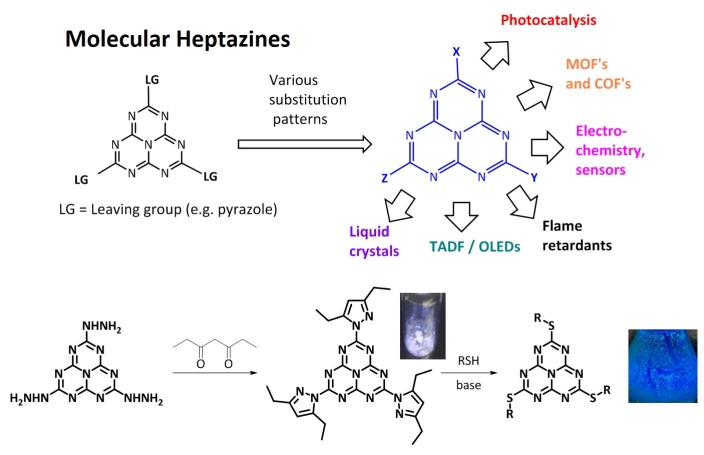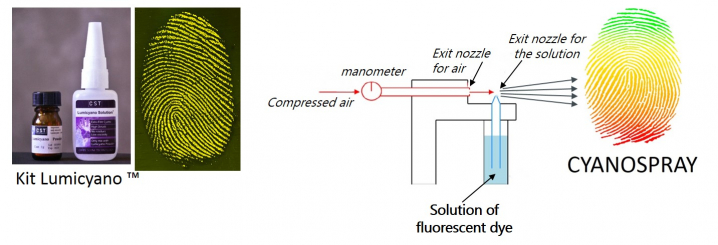Theme A: towards new fluorescent molecules with high-added value
Pollutant detection and analysis of concrete (I. Leray, C. Mongin)
We are developing new fluorescent probes for toxic cations (Al3+, UO22+) and neutral molecules, notably pesticides (atrazine, glyphosate). New structures are studied in silico in collaboration with A. Perrier (i-CLeHS, CHIMIE PARISTECH - PSL), in order to determine the most affine system towards these pollutants. They are then synthesized and incorporated into microfluidic systems.
On the other hand, we are developing a pH optode in order to follow in situ the ageing of cement materials from the setting to several months/years, with the final objective of realizing an operational demonstrator on real site. For this, we design, synthesize and study the photophysical properties of fluorescent molecular probes with a very high pKa (13-13.5) and then incorporate these molecules in a water permeable material. The probe/matrix assembly is then integrated into a connected opto-mechanical component. Finally, an optical bench allowing the measurement of the pH has been realized and tested on solutions or on cement pastes. This work is carried out in collaboration with A. Dauzères of IRSN.
In addition, we are developing sensors for aromatic molecules in the gas phase within the framework of a prematuration contract with SATT Paris-Saclay.
High efficiency luminescent compounds (G. Clavier, P. Audebert)
Luminescent compounds have many applications such as in optoelectronic devices like OLEDs or in photocatalysis. Recently, Thermally Activated Delayed Fluorescence (TADF) has been the subject of many developments in these fields. We are interested in the use of new electron accepting nitrogen heterocycles in the preparation of TADF active molecules such as 1,2,4-triazines and heptazines for which a new synthetic route has been developed in the laboratory. The synthesis work is also accompanied by photophysical studies that rely on the laboratory's instrumental park and in particular on an instrument allowing to measure fluorescence decays in time ranging from nanosecond to second developed in the laboratory (see Photophysics plateform). We are also interested in new electron-donating nitrogen heterocycles of the 1,4-dihydro-polycyclic tetrazine type that could be used in various optoelectronic devices.
Security of goods and people (L. Galmiche, P. Audebert, G. Clavier)
The PPSM has developed several solutions in the field of fluorescent solutions applied to forensics and more particularly the detection of latent fingerprints. The commercial product Lumicyano™, resulting from a common research work with the company Crime Science Technology, allows revelation of fluorescent fingerprints in a single step in a fumigation chamber without the need for dye or powder-based post-treatments.
We have also developed a fogging process that allows the fluorescence revelation of papillary traces directly at the crime scene without the need for heavy equipment. This simple and efficient process has been patented. We are currently working to extend its application by testing new fluorescent compounds compatible with standard police lighting sources.
National collaborations
- Dr Aurélie Perrier (i-CLeHS, CHIMIE PARISTECH - PSL)
- Alexandre Dauzères (IRSN)
- Dr. Gaël Zucchi (LPICM, Ecole Polytechnique)
- Pr. Rachel Méallet (ISMO, Université Paris-Saclay)
- Dr. Grégory Pieters (SCBM, CEA Saclay)
- Dr. Géraldine Masson (ICSN, CNRS)
- Pr. Fabrice Rossignol (IRCER, Université de Limoges)
- Pr. Bernard Ratier et Dr Johann Bouclé (XLIM)
- Crime Science Technology
- Dr. Cédric Boissière (LCMCP, Sorbonne Université)
International collaborations
Research contracts
ANR ASTRID
ANR HEPTA-cat
ANR iChiralight
ANR CYANOSPRAY (ended in 2021)
ITN Excilight (ended in 2019)
LabEx CHARMMMAT Projetcs
BTS project - SATT Paris-Saclay
Booster project - ENS Paris-Saclay
Theme A managers













